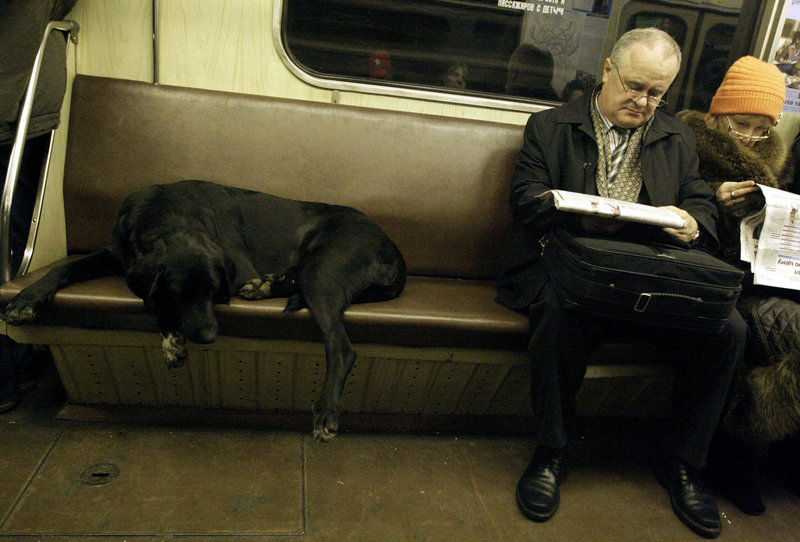MOSCOW — Scroungy and street smart, Moscow’s 26,000 stray dogs roam the Russian capital, bedding down in subway stations and even learning to ride the trains. But some are aggressive, traveling in packs and attacking people.
Now authorities want to round up the strays and send them to an isolation facility outside the city — a plan that has appalled dog lovers and animal rights activists.
Prominent actors and musicians have petitioned City Hall to abandon the idea. Speaking at a news conference Monday, actor Yevgeny Mironov compared the planned facility to a “concentration camp.”
Shipping the animals to a camp in the Yaroslavl region, 150 miles to the northeast, will only promote disease, force the dogs into inhumane conditions and, ultimately, won’t solve the problem, activists said.
Artyom Zverev, a veterinarian with the animal rights charity Bim, warned the facility could become a breeding ground for disease.
In order to ship the dogs out of the city’s borders, the animals need to be quarantined for a month, and the city has no facilities or staff to do that. One ill dog is enough to endanger the whole group, he said.
“If there is an outbreak of a disease, animals will be dying slowly and painfully,” he said.
He also cited examples of similar deportations in other cities where dogs from outlying regions moved into the city, filling in the empty ecological niche.
Moscow’s City Hall says it spent some $45 million on dog shelters, sterilization, and other programs to deal with the city’s huge stray population between 2008 and 2009. But critics say much of the money has gone unaccounted for.
The proposal to ship the dogs far away appears aimed in part at avoiding criticism for harshly efficient dog-control measures like those seen in Bishkek, the capital of the former Soviet republic of Kyrgyzstan. Authorities there say they don’t have enough money to build shelters, so they shoot strays — officials said this year that they expect to kill some 10,000 dogs.
Undertaking bloodshed like that in Moscow could distress the city’s many dog lovers, who often show great affection for the scroungy wanderers.
Many strays have figured out that subway stations and the passages leading to them not only provide shelter from Moscow’s frigid winters, but also offer throngs of people who are often inclined to toss them a snack and regard them with indulgent smiles.
The most enterprising dogs ride on the speedy escalators that lead to the train platforms and frequently take a trip on one of the trains.
The Moscow subway’s seats generally have at least some thin padding, so the train provides a slight step up in comfort from the cold, hard ground. Even when the subways are jammed at rush hour, riders seem disinclined to dislodge a dog who’s sprawled across a seat — though that decision may not be made out of affection but out of fear.
Although the strays in the subway generally behave with remarkable restraint, on the street they can be intimidating and aggressive. They forage in packs, jealously guard their gatherings and sometimes attack passers-by for no apparent cause.
The dogs are such a fixture of the subway that one station features a bronze statue of a stray named Malchik — “Boy” in Russian — who was regarded as sweet-tempered, but who was stabbed to death by a woman who was said to have become angry when he barked at her and her dog.
Deputy Mayor Viktor Biryukov met with two film actors last week and promised to review the deportation plan at a meeting today, activists said, but they are still wary of promises.
“We’ve heard these promises before so we still have concerns that they will not follow through this time,” said Natalya Yunitsyna, head of a charity called The Hope Bringers.
Send questions/comments to the editors.



Success. Please wait for the page to reload. If the page does not reload within 5 seconds, please refresh the page.
Enter your email and password to access comments.
Hi, to comment on stories you must . This profile is in addition to your subscription and website login.
Already have a commenting profile? .
Invalid username/password.
Please check your email to confirm and complete your registration.
Only subscribers are eligible to post comments. Please subscribe or login first for digital access. Here’s why.
Use the form below to reset your password. When you've submitted your account email, we will send an email with a reset code.